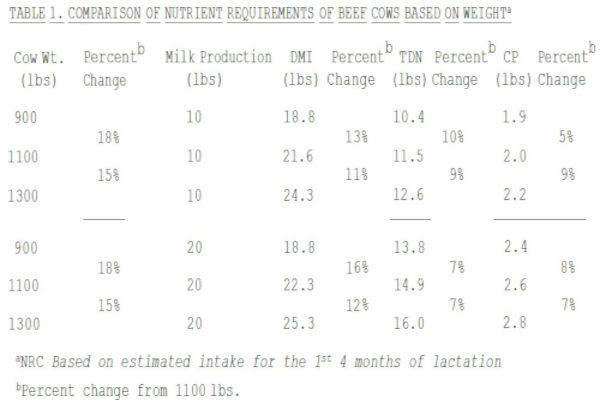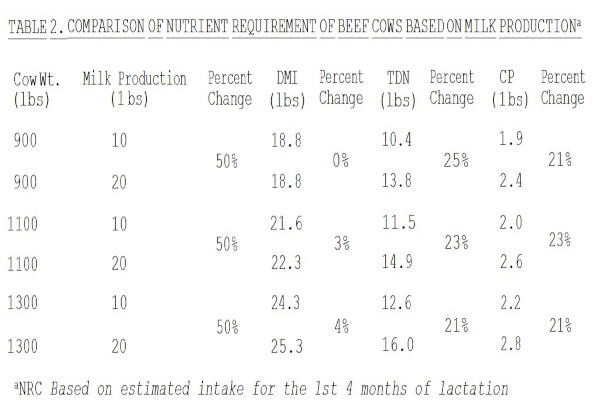By Steve Boyles
Type differences exist due to size, milk production, suitability to the environment and desirability of different types for profit. All these factors affect the amount of nutrients required by the individual. The nutrient requirements of the various types can determine different management schemes.
There are several segments of the industry that influence size of beef cattle. The packer-grocery store segment has preferred USDA Choice carcasses in the 700 to 900 lb range. The feedlot operator is looking for calves that have an acceptable dressing percent and attain USDA Choice grade at 1100 to 1400 lbs (weights have been somewhat heavier in 2020). Various combinations of different bulls and cows can accomplish this goal.
Size and Nutrition: Considerable changes in outputs and requirements per animal may be induced by changes in cow size. Table 1 illustrates the effects of change in cow size has on nutrient requirements. An increase in live weight of approximately 15-18% increases dry matter intake (DMI) about 12-16%. Total digestible nutrients (TDN) and crude protein (CP) requirements are increased at somewhat lower percentages compared to an 18% increase in cow liveweight. The lower increase in requirements, TDN and CP, compared to liveweight alter the amount of calf expected per cow.
Let’s say that we expect a 1000-pound cow to wean a 500 lb calf or 50% of her body weight. The 1300 lb cow should be expected to wean a calf of 565 lbs. This is only about 47% of her body weight. These figures are based on her increased nutrient requirement and not body size or body weight. Comparisons of size should account for differences in weight and condition. Fat cows may have lower maintenance requirements than thin cows. Is cow condition a reflection of milk production?
Milk Production and Nutrient Requirements: The nutrient needs of a cow are related to her size and milk production. The energy required for milk production is directly proportional to the amount of milk she produces for a given cow of a given size. An increase from 10 lbs per day to 20 lbs per day (50%) results in approximately a smaller increase in dry matter intake compared to increases in TDN and CP (table 2). Cow size limits gut fill and thus dry matter intake for milk production at a given weight. Since intake cannot be increased, feed quality must be increased. High milk producing cows must have access to high quality pasture, hay or silage. High milking cows will more rapidly lose condition (milk off her back) on an inadequate ration compared to lower milking cows. This may result in longer postpartum intervals for high milk producing cows on low quality roughages. Thus, these results suggest that maintenance requirements per unit weight, metabolic weight or size differed little due to weight per se but that genetic potential for milk did alter production requirements. High milking and low milking cows can be fed together during most of the year. It is only during lactation that separate feeding arrangements need be considered.
Environment and Nutrient Requirements: Your farm conditions determine the type of cows to have. Annual rainfall, humidity and temperature affect the amount of forage grown and thus carrying capacity of your pastures. Larger, heavier milking cows are capable of weaning heavier calves. High producers also require more feed. Thus, based one fixed land requirement, not as many large or heavy milkers could be kept compared to small, lower milking cows. Annual rain fall, temperature, and day length can determine type and quality of forage grown from year to year which can affect milk production.
Previous research between and within breed have shown that individual animal performance is affected by the type of environment their ancestors evolved. The constancy of relative feeding levels found between breeds has implications when selecting for rapid gain in cattle reared under widely fluctuating nutritional conditions. Selection during periods of abundant feed would tend to favor individuals and breeds of high growth capacity (high fasting metabolism and high food intake). This, however, would reverse during periods of nutritional stress. It is likely that breeds which have evolved under poor nutrition, such as Bos indicus breeds have been automatically selected for lower fasting metabolism and consequently lower growth rates. This means, however, that the Bos indicus breeds may be more adapted to fluctuating feed supplies than Bos tarus breeds in hot environments. This may not be of practical importance to feedlot cattle since nutrition is kept fairly constant but could be of value to stocker and cow-calf producers (appetite and production) stress-production susceptibility.
First, under conditions of low food availability, growth rate is highest in animals with low maintenance. Secondly, in hot or cold climates, growth rate is correlated to heat and cold tolerance. Thirdly, when animals are near maintenance or losing weight, their resistance to many parasites and diseases is reduced on low planes of nutrition. The animals with the highest maintenance requirement could be expected to be the first to lose weight and succumb to parasites and diseases. Selection for growth rate in the presence of any or all of the environmental stressors would favor animals with low maintenance requirements. A cow-calf producer should consider the merits and detriments of various types of cattle, drought or blizzard conditions, along with performance in optimum environments. Residual Feed Intake (RFI) is one of the avenues being pursued to evaluate cow efficiency.
Summary: An overall ideal type does not exist. There is only the type that most completely fits with the management and nutrition that you can provide. Type is extremely important to the cow-calf industry because it directly affects profits and productivity. Cattle type influences (1) reproductive performance, (2) calf weaning weight, (3) feed requirements of the cow-calf unit and (4) selling price. . . We need to match our cows to our forage resources.

